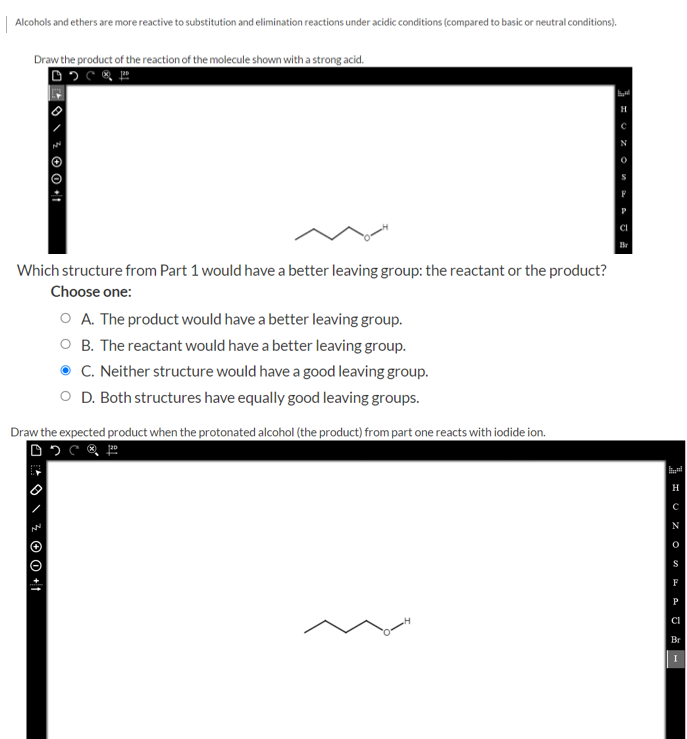Alcohols and ethers are more reactive to substitution and elimination reactions under acidic conditions (compared to basic or neutral conditions). Draw the product of the reaction of the molecule shown with a strong acid. 0 0 0 1 Which structure from Part 1 would have a better leaving group: the reactant or the product? Choose one: O A. The product would have a better leaving group. O B. The reactant would have a better leaving group. C. Neither structure would have a good leaving group. O D. Both structures have equally good leaving groups. Draw the expected product when the protonated alcohol (the product) from part one reacts with iodide ion. ⒸO +1
Alcohols and ethers are more reactive to substitution and elimination reactions under acidic conditions (compared to basic or neutral conditions). Draw the product of the reaction of the molecule shown with a strong acid. 0 0 0 1 Which structure from Part 1 would have a better leaving group: the reactant or the product? Choose one: O A. The product would have a better leaving group. O B. The reactant would have a better leaving group. C. Neither structure would have a good leaving group. O D. Both structures have equally good leaving groups. Draw the expected product when the protonated alcohol (the product) from part one reacts with iodide ion. ⒸO +1
Chemistry by OpenStax (2015-05-04)
1st Edition
ISBN:9781938168390
Author:Klaus Theopold, Richard H Langley, Paul Flowers, William R. Robinson, Mark Blaser
Publisher:Klaus Theopold, Richard H Langley, Paul Flowers, William R. Robinson, Mark Blaser
Chapter20: Organic Chemistry
Section: Chapter Questions
Problem 48E: The foul odor of rancid butter is caused by butyric acid, CH3CH2CH2CO2H. (a) Draw the Lewis...
Related questions
Question

Transcribed Image Text:Alcohols and ethers are more reactive to substitution and elimination reactions under acidic conditions (compared to basic or neutral conditions).
Draw the product of the reaction of the molecule shown with a strong acid.
O ² ⒸO +1
Which structure from Part 1 would have a better leaving group: the reactant or the product?
Choose one:
O A. The product would have a better leaving group.
OB. The reactant would have a better leaving group.
C. Neither structure would have a good leaving group.
O D. Both structures have equally good leaving groups.
Draw the expected product when the protonated alcohol (the product) from part one reacts with iodide ion.
DOC
20+1
H
CI
Br
H
C
F
P
Cl
Br
I
Expert Solution
This question has been solved!
Explore an expertly crafted, step-by-step solution for a thorough understanding of key concepts.
This is a popular solution!
Trending now
This is a popular solution!
Step by step
Solved in 3 steps with 2 images

Knowledge Booster
Learn more about
Need a deep-dive on the concept behind this application? Look no further. Learn more about this topic, chemistry and related others by exploring similar questions and additional content below.Recommended textbooks for you

Chemistry by OpenStax (2015-05-04)
Chemistry
ISBN:
9781938168390
Author:
Klaus Theopold, Richard H Langley, Paul Flowers, William R. Robinson, Mark Blaser
Publisher:
OpenStax

Chemistry
Chemistry
ISBN:
9781305957404
Author:
Steven S. Zumdahl, Susan A. Zumdahl, Donald J. DeCoste
Publisher:
Cengage Learning


Chemistry by OpenStax (2015-05-04)
Chemistry
ISBN:
9781938168390
Author:
Klaus Theopold, Richard H Langley, Paul Flowers, William R. Robinson, Mark Blaser
Publisher:
OpenStax

Chemistry
Chemistry
ISBN:
9781305957404
Author:
Steven S. Zumdahl, Susan A. Zumdahl, Donald J. DeCoste
Publisher:
Cengage Learning


Chemistry: An Atoms First Approach
Chemistry
ISBN:
9781305079243
Author:
Steven S. Zumdahl, Susan A. Zumdahl
Publisher:
Cengage Learning

Organic Chemistry
Chemistry
ISBN:
9781305580350
Author:
William H. Brown, Brent L. Iverson, Eric Anslyn, Christopher S. Foote
Publisher:
Cengage Learning

Chemistry & Chemical Reactivity
Chemistry
ISBN:
9781337399074
Author:
John C. Kotz, Paul M. Treichel, John Townsend, David Treichel
Publisher:
Cengage Learning